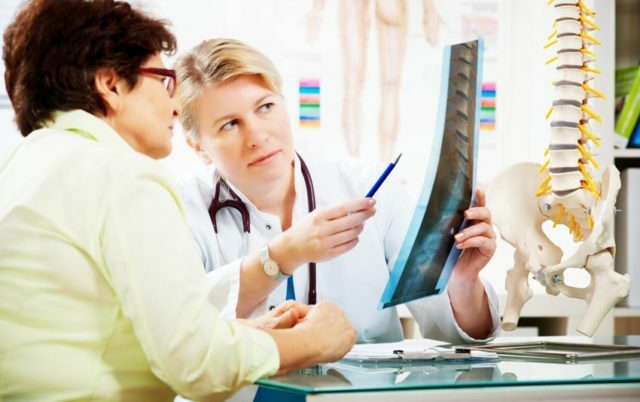
Contents of the page
- 1 Spondylarthrosis of the spine - how it develops
- 2 Reasons for
- 3 Classification of
- 4 Symptoms of spinal fusion
- 5 Conservative treatment of
- 6 Operations of
Spondylarthrosis of the spine refers to degenerative diseases of the spinal column and represents arthrosis of intervertebral( facet, arcuate) joints. Very often the development of changes in facet joints is preceded by a change in intervertebral disks - in this case, arthrosis is called secondary.
Primary spondylarthrosis as an independent disease is a rare option and is associated either with posttraumatic changes or with chronic overload of the spinal column.
Spondylarthrosis of the spine - how it develops
Osteochondrosis changes - decrease in the height of the intervertebral discs - leads to an increase in the load on the arcuate joints.
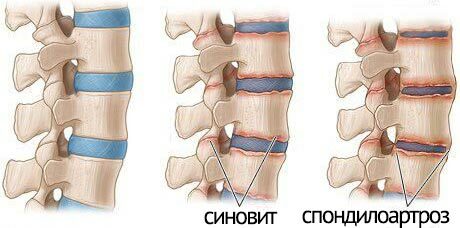
If nothing changes, then synovitis develops sequentially - inflammation of the joint membrane, joint effusion accumulates between the facet joints( inflammatory fluid), the articular cartilage gradually disintegrates, the joint surfaces are sclerosed, the joint capsule stretches and develops a small subluxation.
The joint, together with its ligamentous apparatus, turns into a source of irritation of spiny nerve sprigs. Subsequent pathological changes may lead to the development of stenosis of the intervertebral foramen.
Incompleteness of the joint requires an increase in the area of the support - this is how osteophytes arise, marginal growths that increase the volume of contiguous joint surfaces. As a result of compensatory changes, osteophytes, nevertheless, limit the mobility of the joint and can compress a number of underlying vascular-neurological formations.
Impulses from the affected area are capable of forming complex reflex pains, both local and reflected. The totality of these painful sensations is called facet syndrome.
Causes of
In addition to osteochondrosis, the causes of spinal cord spondyloarthrosis may be:
- Developmental anomalies - lumbarization of the first sacral vertebra( increase in the number of lumbar vertebrae to 6) and, conversely, sacralization of the last lumbar with a decrease in the number of lumbar vertebrae to 4;asymmetry of the intervertebral joints, which results in an uneven load distribution;not fully completed formation of vertebra arches.
- Among the injuries, the most common cause is a subluxation of the vertebral joints.
- Spondylolisthesis - displacement of vertebral bodies relative to each other.
- Instability of vertebral bodies.
Predisposing factors are: 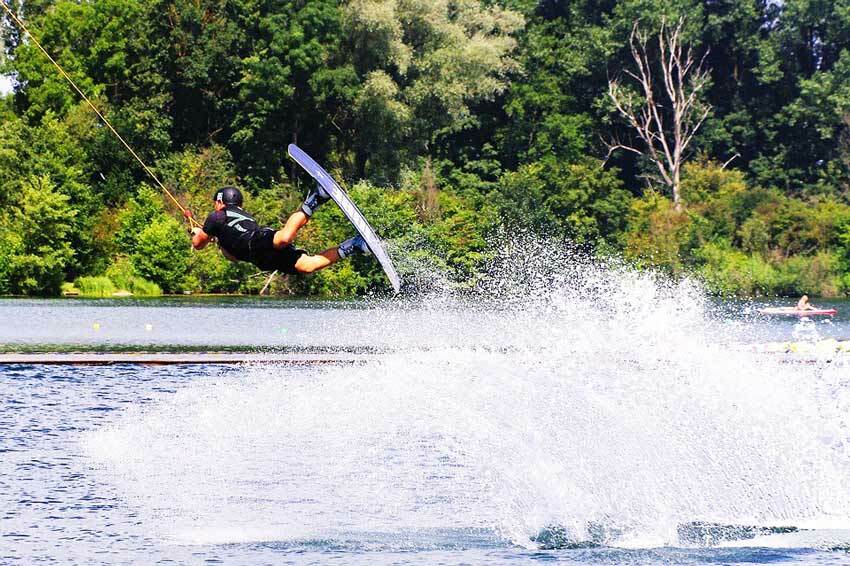
- High and regular loads on the spine, including professional sports.
- Obesity.
- Belonging to the female sex( metabolism in the post-menopausal period accelerates the development of degenerative-dystrophic changes).
- Age is more than 65 years.
- Flat feet.
- Diseases of the autoimmune nature.
- Diabetes mellitus.
- Incorrect power.
- Hereditary predisposition.
Classification of
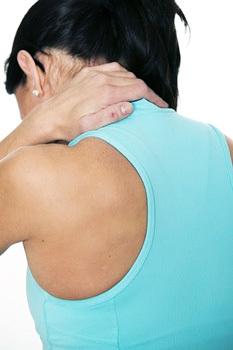 Cervical spondylarthrosis often develops at the level of its upper and middle third. Quite often, the reason for the onset of pain in the thoracic region is not osteochondrosis or herniation of the disc, namely arthrosis of the facet joints. As for the lumbar region, here arthrosis changes can help narrow the intervertebral openings and cause radiculitis pains by squeezing the underlying nerve root.
Cervical spondylarthrosis often develops at the level of its upper and middle third. Quite often, the reason for the onset of pain in the thoracic region is not osteochondrosis or herniation of the disc, namely arthrosis of the facet joints. As for the lumbar region, here arthrosis changes can help narrow the intervertebral openings and cause radiculitis pains by squeezing the underlying nerve root.
Actually, spondylarthrosis is classified according to the location of the process:
- arthrosis of facet joints of the cervical region - cervicoarthrosis;
- spondylarthrosis of the thoracic spine of is called dorsatrosis;
- spondylarthrosis of the lumbar spine - lumbararthrosis;
- with pondiloarthrosis of the sacrum of the spine is somewhat misunderstood,
because the sacrum is a massive single bone derived from intergrown sacral vertebrae, in which it is difficult to isolate the intervertebral joints as a separate anatomical unit.
It is possible to distinguish arthrosis of the lumbosacral part in the place of the lumbosacral junction, no more.
There is also a classification according to the stages of development: 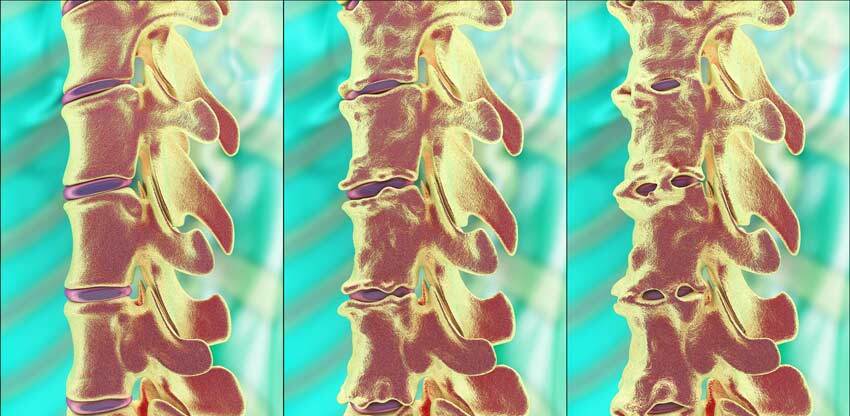
- The 1st stage is characterized by asymptomatic course of the disease. The processes of arthrosis are at the initial stage of development - minor changes in the synovial membrane, ligamentous apparatus.
- At the 2 nd stage, the first symptoms appear: the spine loses its former mobility, its fatigue and pain appear in the back. From the side of the intervertebral disc, damage to the fibrous ring can be noted.
- At the third stage, the cartilage surface of the joint is no longer cartilaginous. Inflammatory processes penetrate deeper. Appearance of bone growths - osteophytes, marked violation of ligament function.
- At the 4th stage, fixation of affected joints occurs - ankylosis, the motor activity in the affected area is severely affected. Sprouting on the edges of the articular surfaces reach significant dimensions, there are problems with innervation and blood flow in the same area. At this stage, all the changes are irreversible.
Depending on the course of pathogenesis, changes in arched joints can be divided into the following variants:
-
 degenerative - the articular surfaces of the facet joints are almost completely destroyed, the process affects the bone structure, degeneration is irreversible;
degenerative - the articular surfaces of the facet joints are almost completely destroyed, the process affects the bone structure, degeneration is irreversible; - deforming - more pronounced marginal bony growths;
- dysplastic type - characterized by restructuring of the bone structure;
- ankylosing type - in fact, corresponds to the 4 th stage, there is a tendency to rapid development of ankylosis.
Often accompanies spondylarthrosis spondylosis of the lumbar spine.
Symptoms of spinal cord spondylarthrosis
For patients with spondylarthrosis, the following symptoms are typical:
-
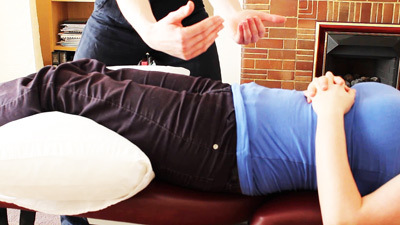 morning stiffness in the spine( in the affected area, especially pronounced if the patient has spondyloarthrosis of the lumbar spine);
morning stiffness in the spine( in the affected area, especially pronounced if the patient has spondyloarthrosis of the lumbar spine); - meteosensitivity - pain can manifest itself in sudden temperature changes, in rainy weather, during frosts;
- pain syndrome is often due to high physical exertion - the pain grows gradually, during the day, and by evening it becomes unbearable;
- pain disappears if the patient occupies a certain position: horizontal position on a flat surface, legs bent in the hip and knee joints;
- pain in the spine is enhanced by prolonged exposure in one position, especially when standing.
In the latter case, the arcuate joints are very loaded. Because of the relatively narrow foraminar openings, there is a risk of compression of the nerve roots. The same situation develops with prolonged walking, with the descent or deflection of the head back.
Pain in spondylarthrosis is diffuse, diffuse - the patient is unable to delineate the border of the affected area.
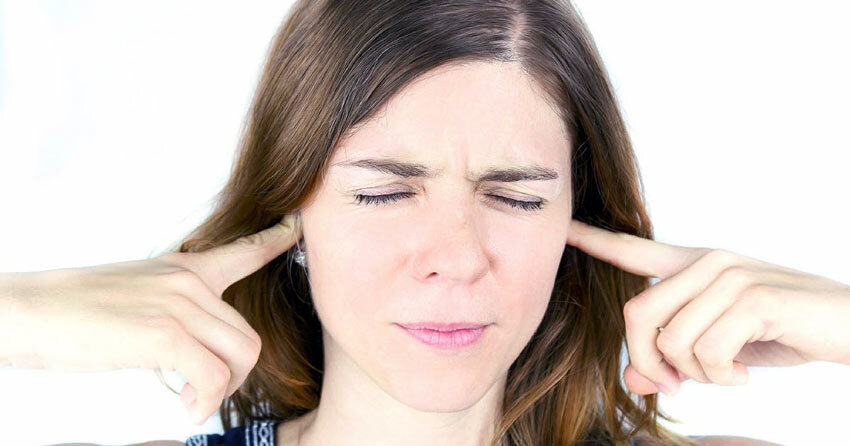 Symptoms of spinal cord spondylarthrosis may be indirect and do not point directly to the source of the pain. In this case, the clinic will depend on the localization of the process.
Symptoms of spinal cord spondylarthrosis may be indirect and do not point directly to the source of the pain. In this case, the clinic will depend on the localization of the process.
Cervicosaarthritis:
- tinnitus;
- headache( in the occiput);
- pain in the hands, shoulders, shoulder blades;
- crunch in the neck with its slopes.
Spondylarthrosis of the thoracic spine shows itself as the next clinic:
- numbness of the hands;
- unpleasant, unusual sensations in the hands( crawling crawl).
When the process is localized in the lumbar region, the pain often radiates to the lower abdomen, buttocks, and the groin.
Diagnosis
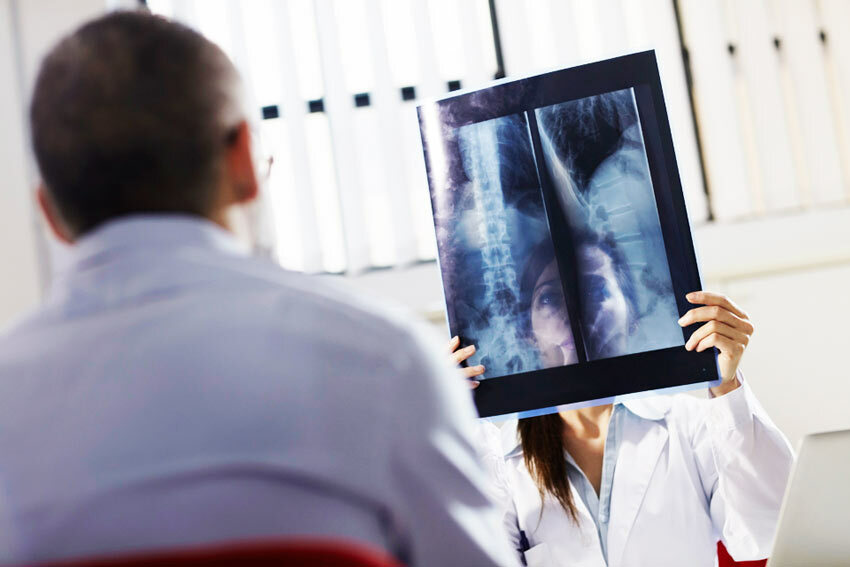 If a patient calls before assigning additional methods of examination, the doctor conducts a thorough questioning and examination of the patient for complaints. Usually in the role of such a specialist is a neurologist, orthopedist or - at the initial stage - a district therapist.
If a patient calls before assigning additional methods of examination, the doctor conducts a thorough questioning and examination of the patient for complaints. Usually in the role of such a specialist is a neurologist, orthopedist or - at the initial stage - a district therapist.
The doctor studies the atrophy of the back muscles, changes the mobility of the spine, the violation of posture, specifies the length of time the pain is disturbed.(After this, the therapist usually appoints a consultation of a neurologist or orthopedist and the patient falls into the hands of a specialist).
The next stage is the X-ray examination of the spine department involved in the process in two projections. The study is performed with preliminary preparation in the form of an exception of gas-forming food the day before the radiography and enema the night before.
 Radiography shows changes in the form of sclerosing articular surfaces, edge proliferation, narrowing of the joint slits. This method allows diagnosing spinal spondylarthrosis from the second stage of the disease.
Radiography shows changes in the form of sclerosing articular surfaces, edge proliferation, narrowing of the joint slits. This method allows diagnosing spinal spondylarthrosis from the second stage of the disease.
More accurate diagnostic is RKT - X-ray computed tomography, which is usually performed with the introduction of contrast medium - in order to clarify the presence and degree of stenosis of the foraminar openings( with a suspected complication of spondylarthrosis by compression of the nerve root).
Radiographic methods, including CT, do not allow a clear visualization of pathology in the event that it has not passed to the bone structure. Cartilage changes can be traced only to MRI, even with the first stage of arthrosis.
For differential diagnosis, radioisotope scanning( rarely) can be used.
Cervical spondylarthrosis in some cases leads to a violation of blood flow through the vertebral artery. To assess the degree of change, angiography and ultrasound of the neck vessels with dopplerography are used( the latter more often).
Diagnostic( and at the same time medical) procedure - blockade. An analgesic and anti-inflammatory substance( more often a steroid and novocaine) is injected into the joint cavity, which temporarily relieves the pain syndrome in the event that the joint is affected. The disappearance of pain is an argument in favor of arthrosis.
Complications of
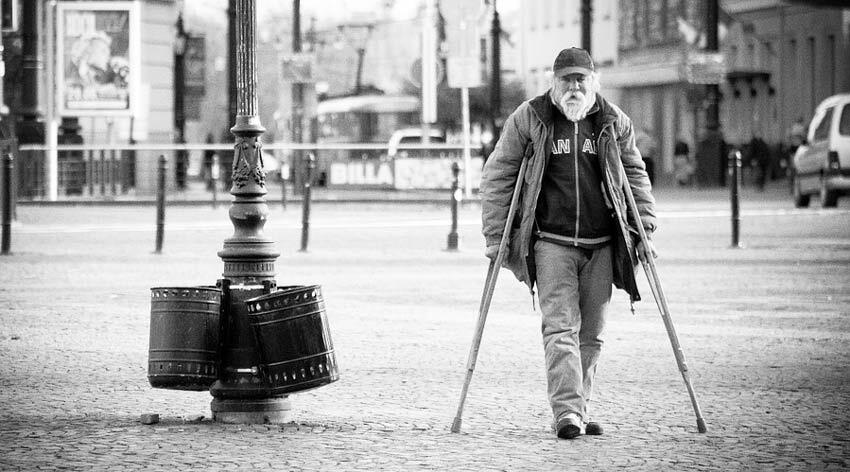 In the late stages of the disease complications often develop:
In the late stages of the disease complications often develop:
- compression and damage to the vertebral artery;
- instability of the spinal column;
- disability( motor and sensory disorders);
- spondylolisthesis;
- pelvic disturbances.
Conservative treatment of
Conservative treatment means a combination of non-medicinal effects and the use of medicines. Most commonly, the following drugs are used from medicines: 
- non-steroidal anti-inflammatory drugs( flupirtene, meloxicam, aceclofenac, nimesulide);
- antiepileptic drugs( with the development of neuropathic pains) - pregabalin;
- antidepressants - fluoxetine, amitriptyline;
- muscle relaxants - tizanidine, tolperisone( known as midol);
- vitamins that promote partial recovery of neuromuscular conduction( thiamin, pyridoxine, cyanocobolamine);
- for blockade - steroids and anesthetics;
- substances that promote cartilage regeneration - glucosamine and chondroitin sulfate.
In severe cases, narcotic analgesia is used, angioprotective drugs are added( to improve microcirculation), steroids and general metabolic drugs( cytoflavin).
With regard to non-pharmacological techniques, this includes: 
- Acupuncture, which allows you to eliminate muscle spasm and affect the blood flow in the affected area.
- Kinesiotherapy is a teaching technique by which a patient can independently exercise exercise therapy at home during periods of remission and aggravation.
- Physiotherapy - used even in the acute phase - but not at the peak of the pain syndrome. This includes many techniques, ranging from electrophoresis and ending with magnetotherapy. Treatment is selected by a doctor.
- Manual therapy eliminates functional problems in the affected segment, muscle tension, helps improve local microcirculation.
- Massage - responsible for the normalization of tissue nutrition due to the acceleration of metabolism, restoration of blood and lymph circulation. With a deep massage, you can block pain impulses from the peripheral nervous system. Improving the trophy allows you to quickly remove the decay products.
- Psychotherapy. It is necessary to correct the mental state of patients with spondylarthrosis, which often have to deal with debilitating pain.
Operations
At the moment, a considerable number of operations have been invented that make it possible to alleviate the condition of patients with this pathology. These include: 
- radiofrequency denervation( coagulation of the nerve endings involved in the pathological process - usually the nerve Lyushka - with the help of an electrode);
- chemical denervation( using an alcoholic anesthetic solution);
- decompressive intervention( at the level of microsurgery - often removing the arch of the overlying vertebra);
- posterior interbody fusion( the affected motor segment is stabilized with the implant, while simultaneously decompressing vascular and neural structures);
- transpedicular fixation( through the arch of the vertebrae, screws are inserted to fix the vertebral segment.) After a while, after the formation of bone fusion, the metal structure can be removed).
- Surgery for spondylarthrosis is rare. For this, serious indications are needed:
- motor or sensitive limb disorders;
- pelvic disorders( problems with urination, defecation);
- marked foraminar stenosis;
- severe forms of spinal instability.
Prevention
 To prevent the development and progression of the disease, the following simple recommendations should be followed:
To prevent the development and progression of the disease, the following simple recommendations should be followed:
- disposal of excess weight;
- regular exercise( necessarily light, not leading to fatigue, overexertion);
- if possible - change of work, if it is associated with a monotonous pose or a warm-up after each working hour;
- correct, full and rational nutrition;
- correct load distribution when carrying weights( a backpack with wide straps is preferable to a bag through one shoulder);
- prevention of injuries( failure of an excessively high heel, platform);
- daily walks for short distances( 3-4 km);
- orthopedic shoes;
- correctly organized bed( pillow and mattress).
The more items from this list will be executed, the less likely the transition of spondyloarthrosis to a severe stage.



